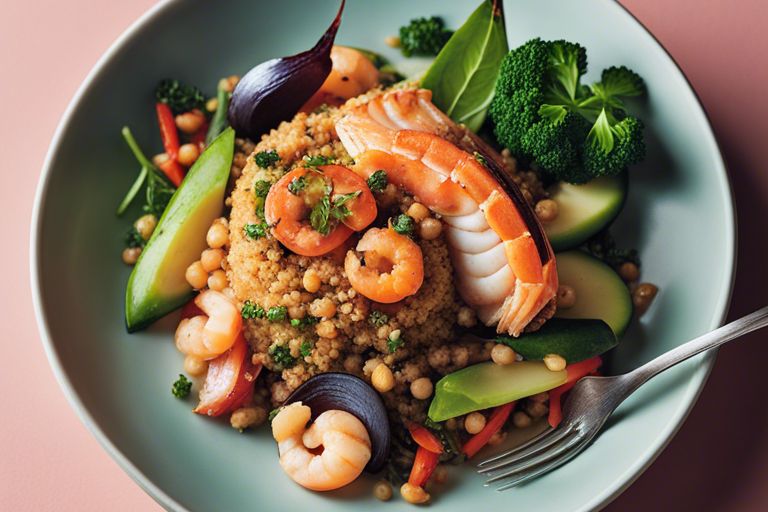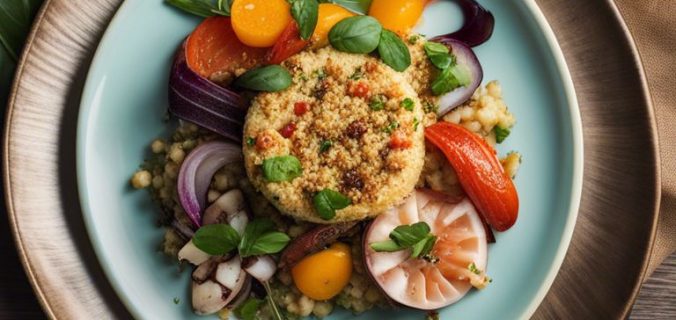Many individuals are turning to quinoa as a versatile and nutritious grain to incorporate into their diets. This superfood is not only packed with protein but also contains vital amino acids, fiber, and antioxidants. In this blog post, we will explore how quinoa can elevate your plant-based seafood game by providing a healthy and delicious alternative to traditional seafood dishes. Whether you are a vegan, vegetarian, or simply looking to incorporate more plant-based options into your diet, quinoa can be a game-changer in your culinary repertoire.
Key Takeaways:
- Quinoa offers a complete protein source: Quinoa is a plant-based protein that contains all nine necessary amino acids, making it a nutritious choice for those following a vegetarian or vegan diet.
- Quinoa adds texture and flavor to plant-based seafood dishes: Quinoa’s nutty taste and slightly chewy texture can enhance the overall eating experience of plant-based seafood dishes, providing a satisfying alternative to traditional seafood.
- Quinoa is versatile and easy to incorporate into recipes: Quinoa can be used in a variety of dishes, from salads to patties, making it a versatile ingredient that can elevate the taste and nutritional profile of your plant-based seafood creations.

Quinoa in Seafood Alternatives
Nutritional benefits of quinoa
Even though quinoa is not a seafood alternative itself, it plays a crucial role in enhancing the nutritional profile of plant-based seafood. Quinoa is a complete protein, providing all nine vital amino acids, making it an excellent addition to seafood alternatives for those following a plant-based diet. Additionally, quinoa is rich in fiber, vitamins, and minerals, offering a wholesome and nutritious option for those seeking a more balanced diet.
Textural advancements in plant-based seafood
On the forefront of innovation in plant-based seafood alternatives is the incorporation of quinoa for its unique textural properties. Quinoa’s versatility allows it to mimic the flakiness and firmness of seafood, providing a satisfying mouthfeel that closely resembles traditional seafood products. By integrating quinoa into plant-based seafood formulations, manufacturers can create products that not only taste delicious but also have a pleasing texture that mimics the real thing.
Textural advancements in plant-based seafood have been a game-changer for those looking to transition to a more sustainable and ethical diet. By utilizing quinoa as a key ingredient, manufacturers have been able to create seafood alternatives that not only taste great but also provide a texture that closely mimics traditional seafood products. This innovation opens up a world of possibilities for those seeking to enjoy the flavors of the sea while making a positive impact on the environment.
Crafting Plant-Based Seafood Dishes with Quinoa
Recipes and preparation techniques
While quinoa is commonly known as a staple grain, its versatility makes it a perfect ingredient for crafting plant-based seafood dishes. It can be used to create delicious vegan crab cakes, fishless fillets, or even tuna salad alternatives. By mixing cooked quinoa with flaked plant-based seafood options such as hearts of palm or jackfruit, you can achieve a texture that closely resembles traditional seafood.
Flavor pairing and seasoning tips
Crafting flavorful plant-based seafood dishes with quinoa involves strategic flavor pairing and seasoning. Elevate the taste by incorporating zesty citrus flavors like lemon or lime to mimic the freshness of the sea. Seasoning tips include using seaweed flakes for a hint of oceanic essence, or Old Bay seasoning for a classic seafood taste. This will enhance the overall experience and create a more authentic seafood flavor profile.
Sustainability and Ethical Considerations
Unlike traditional seafood options, plant-based seafood offers a sustainable and ethical alternative that is gaining popularity among conscious consumers. Elevate your salad game with the perfect blend of quinoa that complements plant-based seafood dishes perfectly.
Environmental impact of traditional vs. plant-based seafood
An important aspect to consider is the environmental impact of traditional seafood harvesting compared to plant-based seafood production. Traditional seafood often leads to overfishing, damage to marine ecosystems, and bycatch of non-target species. In contrast, plant-based seafood does not contribute to these issues and reduces the strain on the world’s oceans.
Ethical implications of shifting to plant-based options
To fully understand the ethical implications of shifting to plant-based seafood options, it is necessary to consider the welfare of marine life. Traditional seafood production involves practices that can be harmful to the well-being of fish and other marine creatures. By choosing plant-based alternatives, consumers can support ethical treatment of animals and promote sustainability in the food industry.
As consumers become more informed about the environmental and ethical impact of their food choices, the shift towards plant-based seafood is a positive step in the right direction.
Marketing Plant-Based Seafood to Consumers
Understanding consumer preferences
Not all consumers are on the same page when it comes to plant-based seafood. One key factor in understanding consumer preferences is recognizing that taste, texture, and convenience play a crucial role in their decision-making process. Some consumers may prioritize sustainability and health benefits, while others may be more interested in how closely the alternative mimics the taste and experience of traditional seafood.
Strategies for restaurant and product positioning
Strategies for positioning plant-based seafood in restaurants and the market involve thoughtful marketing and strategic placement. Understanding the target audience and catering to their preferences through menu design, promotion, and partnerships with influencers or health-conscious organizations can help elevate the product’s appeal. Finding the right balance between highlighting the sustainability aspect and emphasizing the taste and versatility of plant-based seafood is crucial for successful positioning.
Consumers are becoming increasingly interested in plant-based seafood options due to concerns about overfishing, environmental impact, and personal health. By highlighting the benefits of sustainability, health, and taste, and strategically positioning these products in the market, businesses can effectively attract and retain a growing base of conscious consumers.
FAQ
Q: What is quinoa and why is it beneficial for plant-based seafood?
A: Quinoa is a nutritious whole grain that is high in protein, fiber, and various vitamins and minerals. When used in plant-based seafood dishes, quinoa provides a complete source of protein, making it an excellent meat substitute for those following a vegan or vegetarian diet.
Q: How can quinoa be incorporated into plant-based seafood recipes?
A: Quinoa can be used in a variety of ways to elevate plant-based seafood dishes. It can be mixed with other ingredients such as chickpeas, vegetables, and spices to create flavorful quinoa “crab cakes” or “fish” fillets. Quinoa can also be used as a base for salads or stuffed peppers filled with plant-based seafood alternatives.
Q: What are the health benefits of incorporating quinoa into plant-based seafood meals?
A: By incorporating quinoa into plant-based seafood meals, you not only increase the protein content of the dish but also boost its fiber content. Quinoa is also a good source of vital nutrients like iron, magnesium, and zinc, making it a nutritious addition to any plant-based diet focused on seafood alternatives.

